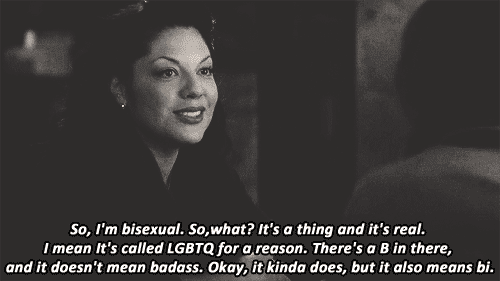
Recurring bisexual characters on television are on the rise,more and more characters are showing romantic and/or sexual interest to more than one gender. While the representation is amazing, it still isn’t what it needs to be. When a gay character is introduced into a show there’s often a scene where that character announces that they are gay. Bisexuals aren’t getting that same treatment —When looking into the bisexual characters of the television world, I found that most never openly stated their sexuality. We aren’t getting that “I am bisexual” moment that gay and lesbian characters receive. What this means, is the casual viewer is left assuming a character is straight or gay, often labeling character’s as just ‘confused’ when it comes to their sexuality. The viewer isn’t being exposed to bisexuality, which only aids in erasing the community further.
One of the first bisexuals on television was witchcraft-practicing Willow Rosenberg on Buffy the Vampire Slayer, she was portrayed as, and still viewed to this day, as a lesbian. Willow had both male and female love interests, expressed her attraction towards both genders, and yet was still seen as Sunnydale’s resident lesbian. Another character that has faced erasure in terms of their sexuality is Arrow’s Sara Lance who had shared romantic interest with both male and female characters.However, when addressed about Sara’s sexuality, producer Marc Guggenheim stated that “In the same episode where we reveal that Sara had had this lesbian relationship, she also is sleeping with Oliver again, and we really wanted to approach it like not be salacious, and be sensitive, and be realistic. We actually specifically avoid using the term ‘bisexual.’ We didn’t want to label her at all.”Not only does Guggenheim believe that a female/female relationship is strictly lesbian, but he’s also making a point to avoid labeling Sara as bisexual.
Unlike Guggenheim, who is trying to erase bisexuality from their show, Jason Rothenberg, creator and executive producer of The 100, is doing almost everything he can to promote it. After the show’s leading lady, Clarke, had her steamy make out session with female counterpart Lexa, Rothenberg tweeted “Clarke is a bisexual character. Remember that in this society, no one’s worried about it. They’re worried about spears to the chest.”While Rothenberg’s open-mildness and acknowledgement of Clarke’s bisexuality was welcomed with warm arms, it’s concerning that it will never be directly dealt with on the show.
For the casual viewer that tunes into The 100 every week, someone who most likely does not follow Rothenberg on twitter, how are they supposed to know that Clarke is bisexual? Where did their minds go after the main character of the show, who only a few episodes ago professed her love to a man, was now kissing a girl?Did the word bisexual even enter their mind? That’s the problem with not directly addressing a character’s sexuality, especially one that is so rarely seen in the media.
While live-tweeters and fandom members of The 100 are rejoicing over the fact that the main character is bisexual, the casual viewer is left unfazed. Which poses as a very real issue when it’s the casual viewer who’s more likely to not know what bisexual means. Someone who is unaware of the various sexualities out there. Who sees straight until proven ga,who allows their mind to stay closed even while being exposed to something new. Which is why when Grey’s Anatomy had their leading bisexual lady, Callie Torres, state the words “I am bisexual”, it was groundbreaking.

Grey’s Anatomy, a show that drew an average of 8.2 million viewers an episode in the eleventh season, just had a beloved character announce her bisexuality. Drunkenly, loudly, and unashamed. Calliope ‘Callie’ Torres has been a main recurring character on Grey’s Anatomy for 8 seasons. It also took her nearly 8 seasons for the word bisexual to ever leave her mouth.
Why did it take so long for Callie, who’s been with both men and women throughout her time on the show, to state her sexuality openly? Why do show runners tweet a character’s sexuality instead of portraying it on the screen? Why are they “trying to avoid” using the word bisexual to describe a character? More importantly, what the hell are they so afraid of? Why is it that Piper Chapman (OITNB) is constantly called a lesbian, even after calling out her fellow supporting characters on their biophobia? Why is it that the audience is left to assume that Heroes’ local cheerleader, Claire Bennet, is just experimenting at college like every other girl does, rather than possibly being bisexual?
Why is it that after the series finale of The Legend of Korra, the audience is left staring at the screen wondering if in fact Korra and Asami are together now?We need more Remy Hadley’s (House), a woman who dated both men and women and became confident and open about her sexuality.We need more Oberyn Martell’s (GOT), a man in a world where being anything other than straight could get you could killed, but who still loved and bed who he pleased with certainty. We need more character’s (and writer’s/producer’s) that aren’t afraid to be open about using the word ‘bisexuality’ as a positive descriptor. We need support.We need to be seen. We need to be heard.But most importantly, we need more representation.


Comments are closed.